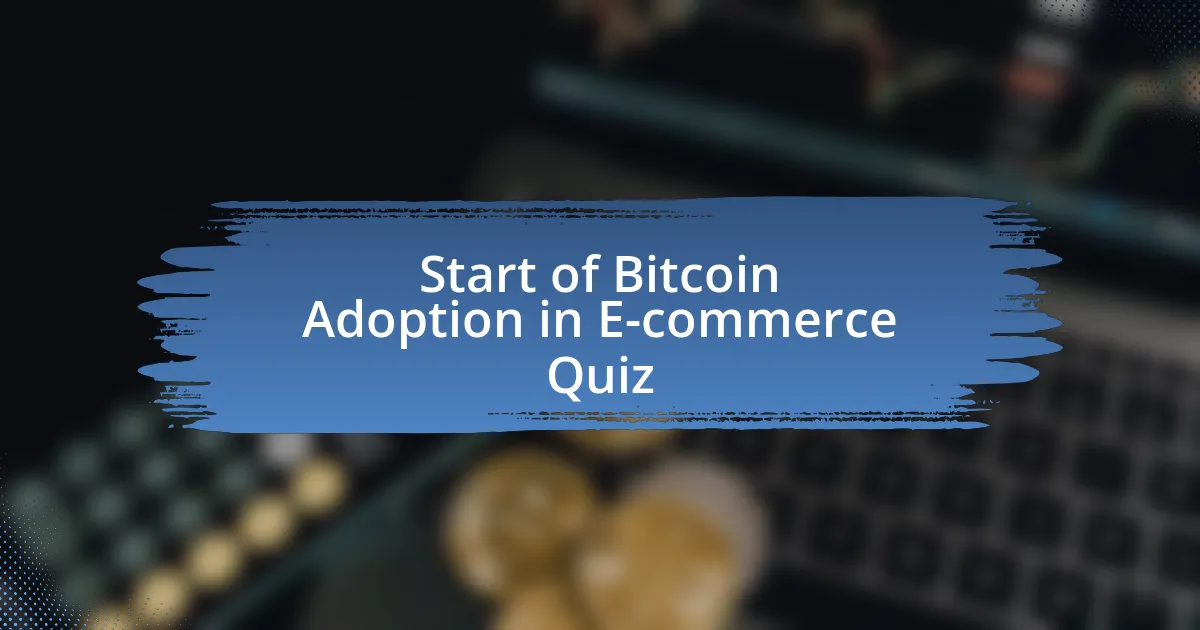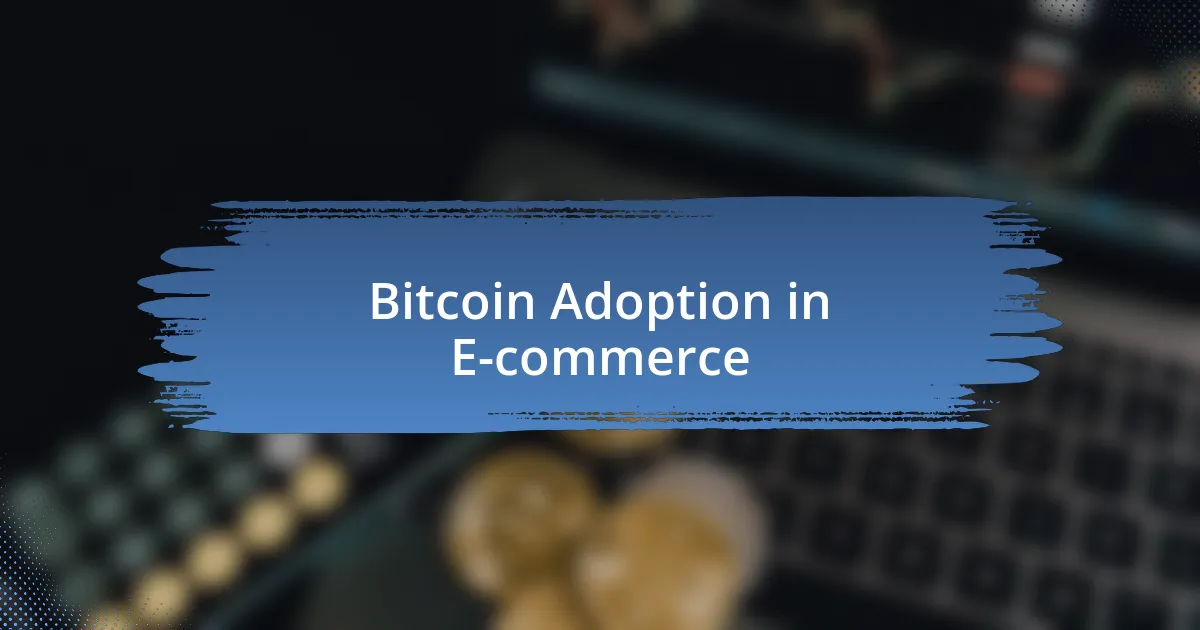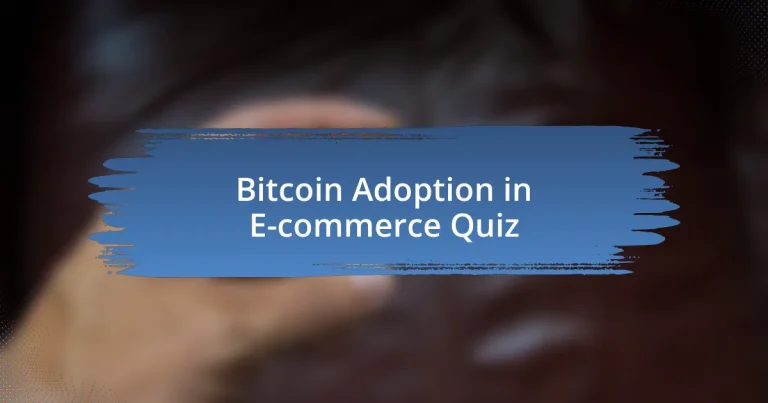
Start of Bitcoin Adoption in E-commerce Quiz
1. What percentage of eCommerce vendors in the U.S. accept cryptocurrency as a payment method in 2024?
- 29%
- 15%
- 37%
- 62%
2. Which cryptocurrency is the top in the U.S., owned by 83% of users in 2023?
- Ripple
- Ethereum
- Bitcoin
- Litecoin
3. What is the estimated revenue generated from cryptocurrency use in the U.S. in 2023?
- $5 billion
- $25 billion
- $50 billion
- $18 billion
4. What is the projected annual growth rate (CAGR) of the cryptocurrency market in the U.S. from 2024 to 2028?
- 15.0%
- 12.3%
- 5.5%
- 9.1%
5. What is the expected market size of the cryptocurrency market in the U.S. by 2028?
- $33 billion
- $10 billion
- $75 billion
- $50 billion
6. Which traditional stock exchange was the first to list Bitcoin futures contracts?
- New York Stock Exchange (NYSE)
- The Chicago Mercantile Exchange (CME)
- London Stock Exchange (LSE)
- NASDAQ
7. What is the name of the off-chain scaling solution being developed to mitigate Bitcoin’s fees and long transaction times?
- Lightning Network
- Sidechain Protocol
- Off-Ramp Solution
- Plasma Chain
8. How often, on average, can we expect a new block to be found by miners?
- 5 minutes
- 10 minutes
- 15 minutes
- 30 minutes
9. What is Bitcoin Pizza Day, May 22nd?
- The date when Bitcoin was first launched in 2009
- A celebrated cryptocurrency festival held annually
- A day dedicated to promoting Bitcoin mining practices
- The day when a computer programmer, Lazlo Hanyecz, paid 10,000 bitcoins for two pizzas in 2010
10. What is SHA 256?
- A method to mine Bitcoin efficiently
- A secure hashing algorithm used by Bitcoin, originally designed by the NSA
- A type of cryptocurrency exchange platform
- A digital wallet for storing cryptocurrencies
11. What is a nonce?
- A type of cryptocurrency transaction
- A random number used in the Bitcoin mining process to prevent pre-computation attacks
- A digital identity verification process for eCommerce
- A method to store large data sets securely
12. Which of the following statements is NOT true about Bitcoin wallets?
- e. To open a wallet you must submit a request to the wallet provider
- a. Bitcoin wallets can hold multiple cryptocurrencies
- b. Bitcoin wallets provide direct access to the Bitcoin blockchain
- c. Bitcoin wallets are necessary to send transactions
13. What percentage of shoppers believe crypto is the future?
- 25.4%
- 50.6%
- 75.1%
- 60.8%
14. Why do some shoppers use cryptocurrency?
- Because they believe it is safer and more secure (35.6%)
- Because they prefer to pay in cash only
- Because it is a legal requirement for their purchases
- Because they want to avoid paying taxes on transactions
15. What is the average ROI for vendors who accept digital currency payments?
- 150%
- 327%
- 225%
- 400%
16. How many countries have banned cryptocurrency?
- At least 19 countries
- Exactly 10 countries
- Over 30 countries
- 5 countries
17. Which country has the most digital currency owners?
- Germany
- Brazil
- India
- China
18. What is the estimated value of the worldwide crypto wallet market by 2033?
- Over $2.1 billion
- Over $5.4 billion
- Over $3.6 billion
- Over $1 trillion
19. What percentage of retail crypto transactions were between $100 to $500 from June 2021 to May 2022?
- 45%
- 72%
- 32%
- 56%
20. How many businesses accept Bitcoin worldwide?
- Approximately 15,174 businesses
- Roughly 25,000 businesses
- Nearly 10,000 businesses
- About 5,000 businesses
21. What is the share of consumers in selected countries in Europe and North America who used cryptocurrency to pay for eCommerce in 2024?
- The most popular payment method for consumers in online shopping in 2024
- The least likely payment method used by consumers in online shopping in 2024 in Europe and North America
- The preferred payment method among consumers in Europe and North America
- Approximately 25% of consumers using cryptocurrency for online shopping
22. Which country stands out in the survey for the use of cryptocurrency in eCommerce?
- Germany
- France
- Austria
- Italy
23. What is the estimated number of cryptocurrency users across the world as of 2023?
- About 300 million
- More than 425 million
- Approximately 500 million
- Nearly 600 million
24. What is the predicted number of B2B cross-border transactions on the blockchain by 2025?
- 250 million
- 745 million
- 1 billion
- 500 million
25. What is the estimated market size of the U.S. cryptocurrency payment apps by 2030?
- $250 million
- $418.5 million
- $300 million
- $1 billion
26. What percentage of shoppers think that using cryptocurrency will increase its overall adoption?
- 21.5%
- 30.2%
- 62.1%
- 45.8%
27. What percentage of shoppers use cryptocurrency because they are unable to cash out their crypto funds?
- 30.2%
- 24.9%
- 40.5%
- 15.8%
28. What percentage of shoppers believe that spending crypto will increase its value?
- 25%
- 39%
- 50%
- 60%
29. What percentage of shoppers do not trust banks?
- 28.7%
- 50.2%
- 35.4%
- 42.1%
30. What percentage of shoppers believe that crypto is safer and more secure?
- 48.9%
- 51.7%
- 35.6%
- 22.4%

Quiz Successfully Completed!
Congratulations on completing the quiz on Bitcoin adoption in e-commerce! It’s great to see your interest in understanding how digital currency is transforming online shopping. Through this quiz, you’ve explored key concepts like transaction speed, security, and the growing acceptance of Bitcoin by various retailers. These insights are crucial in understanding the current landscape of e-commerce.
In this process, many participants discover that Bitcoin not only offers new payment solutions but also raises questions about the future of currency in general. You’ve likely gained a clearer view of how cryptocurrency can change traditional business models. Awareness of both the advantages and challenges of Bitcoin in e-commerce is essential for anyone curious about this financial revolution.
Want to dive deeper? We invite you to check out the next section on this page that further explores Bitcoin adoption in e-commerce. You’ll find valuable information that can enhance your understanding and keep you updated on the latest trends. Let’s continue this educational journey together and uncover more about the exciting future of online transactions!

Bitcoin Adoption in E-commerce
Understanding Bitcoin in E-commerce
Bitcoin is a decentralized digital currency that allows peer-to-peer transactions without intermediaries. It operates on blockchain technology, which ensures transparency and security. In e-commerce, Bitcoin can facilitate cheaper and faster transactions compared to traditional payment methods. Merchants benefit from lower fees and protection against chargebacks. As of October 2023, numerous online retailers accept Bitcoin, indicating a growing acceptance of cryptocurrency in the marketplace.
The Benefits of Accepting Bitcoin in Online Stores
Accepting Bitcoin can lead to reduced transaction fees, as traditional payment processors often charge higher fees. Transactions using Bitcoin can be processed quickly, usually within minutes, enhancing customer experience. Moreover, businesses can tap into a global market without dealing with currency conversion issues. This opens new customer bases that prefer paying with cryptocurrency. Reports show that merchants who accept Bitcoin see increased sales from tech-savvy customers.
Challenges of Implementing Bitcoin Payments in E-commerce
While the benefits are notable, challenges exist in adopting Bitcoin for e-commerce. Price volatility can affect revenue, as Bitcoin’s value fluctuates significantly. Regulatory uncertainty can complicate the legal landscape for businesses. Technical issues, such as the need for secure wallets and systems to handle cryptocurrency transactions, can deter implementation. Educating customers about Bitcoin is also necessary to ensure seamless transactions.
Current Trends in Bitcoin Adoption Among E-commerce Platforms
2023 has seen a notable surge in Bitcoin adoption among e-commerce platforms. Major companies, such as Shopify and Overstock, have integrated Bitcoin payment solutions. Innovations in payment processors, like BitPay, simplify the process for merchants. Surveys indicate that consumers appreciate the option to pay with cryptocurrencies, especially younger demographics. This trend reflects a shift towards more diverse payment options in the e-commerce landscape.
The Future Outlook for Bitcoin in E-commerce
The future of Bitcoin in e-commerce appears promising. With increasing mainstream acceptance, more retailers are likely to explore Bitcoin payments. Developments in technology, such as the Lightning Network, aim to improve transaction speed and reduce fees. Furthermore, regulations may become clearer, fostering a safer environment for businesses. Predictions suggest that Bitcoin could become a staple payment option in the e-commerce sector within the next few years.
What is Bitcoin adoption in e-commerce?
Bitcoin adoption in e-commerce refers to the integration and acceptance of Bitcoin as a payment method by online retailers and services. This practice allows consumers to purchase goods and services using Bitcoin. According to a 2021 survey, over 20,000 merchants globally accepted Bitcoin as a payment option, reflecting its growing acceptance.
How is Bitcoin being adopted in e-commerce?
Bitcoin is being adopted in e-commerce through partnerships with payment processors that facilitate Bitcoin transactions. Companies like PayPal and Shopify enable merchants to accept Bitcoin in a user-friendly manner. In 2021, PayPal reported that 70% of its customers had engaged with its Bitcoin services, highlighting the increasing trend among e-commerce platforms.
Where can consumers use Bitcoin for online purchases?
Consumers can use Bitcoin for online purchases at various retailers, marketplaces, and service providers. Notable examples include Overstock, Newegg, and Expedia, all of which accept Bitcoin as a payment method. As of 2022, it is estimated that more than 15,000 businesses in the U.S. accept Bitcoin for their online transactions.
When did Bitcoin start being adopted in e-commerce?
Bitcoin began being adopted in e-commerce shortly after its launch in 2009, with initial acceptance occurring in 2010. One of the first significant transactions was in May 2010 when a programmer purchased two pizzas for 10,000 Bitcoins. By 2014, major online platforms started to adopt Bitcoin, marking a significant shift in its use for e-commerce.
Who are the key players in Bitcoin adoption for e-commerce?
Key players in Bitcoin adoption for e-commerce include payment processors like BitPay and Coinbase Commerce, which enable merchants to accept Bitcoin. Major retailers such as AT&T, Overstock, and Microsoft have also played pivotal roles by incorporating Bitcoin payment options. These companies have contributed to the growing visibility and usability of Bitcoin in the e-commerce space.


